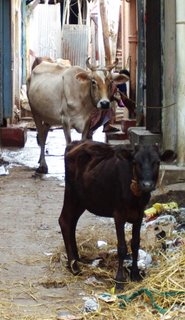Fleshing out our diets

Published October 26 2005
The Daily Targum
Animal activists have got to face the sad reality that most humans like a little meat in their diet, be it cow, chicken or the other white meat.
But, given the mad cow fiasco of a few years ago in Europe, the Foot and Mouth epidemic in Southeast Asia more recently, and now the Avian Flu, perhaps it’s time the meat eaters of this world paid attention to some of what these activists are saying.
Mad Cow Disease, or Bovine Spongiform Encephalopathy (BSE), is “a slowly progressive, degenerative, fatal disease affecting the central nervous system of adult cattle,” according to the US Food and Drug Administration. It broke out in an epidemic in
What was the cause of the epidemic in cows? Farmers had been feeding cattle food prepared from bovine tissues, such as brain and spinal cord matter, which were contaminated by the BSE agent. Their feed also included sheep brain matter, infected with scrapie, the form of the disease manifested in sheep.
But humans have been eating various sentient beings and their brain matter, their intestines and their hooves in McDonald’s hamburger patties for decades, you might say! What’s the big deal?
The odd crop of crazy cows dropping dead wouldn’t have mattered much to us, but alas humans began contracting the disease from BSE-infected beef in the form of variant Creutzfeldt-Jakob Disease (vCJD), a human neurodegenerative disease. While there have only been around 73 cases of vCJD globally so far, scientists have predicted epidemics of up to 250,000 cases of the lethal disease.
As a result, governments across the world have cracked down on cattle and other meat industries, requiring them to eliminate animal parts from feed. The livestock industry in the U.S voluntarily banned sheep and certain other animal parts from their feed, and then the FDA formally banned “any proteins from cows, sheep, goats, deer or elk -- animals that get similar brain-wasting diseases -- from feed for cows, sheep or goats.” Poultry and pigs could still, however, eat these proteins, but their feed would have to be labeled "do not feed to cows or other ruminants" and companies had to have systems to prevent accidentally mixing up the feeds.
Yet, according to the Associate Press, FDA inspections in 2001 found that around 20 percent of U.S feed mills, companies that turn slaughtered animals’ parts in to meat and bone meal, feed considered ‘risky,’ lacked these warning labels and had no system to prevent feed mix-ups.
The next edible animal epidemic to hit the scene was Foot-and-Mouth disease, which affects all cloven-hoofed animals, and is the most contagious of animal diseases, according to the British Journal of Medicine.
The outbreak of foot-and-mouth disease two years ago in
In 2002, The South Korean authorities, trying to contain an outbreak of swine foot and mouth disease, slaughtered more than 55,000 pigs and cattle.
While foot-and-mouth disease (so named because it causes painful blisters in the mouths and on the feet of infected animals) does not pose a health threat to humans (yet), the financial losses from it have been significant in the affected industries.
Avian influenza, the latest of these diseases doesn’t usually infect species other than birds and pigs, according to researchers, but humans came down with the bird flu in 1997 in
The strain of the flu that infected and killed these people then went on to kill 60 others across Asia, in
Hong Kong
Since its appearance in Hong Kong, the Avian Flu has moved on through Asia and has now been detected in
The World Health Organization has said the H5N1 strain of bird flu is endemic in poultry in
Fears that the disease could easily spread across the European and North American continents through migratory bird transmission, and become a pandemic with not only significant economic costs but also threat to humans, have propelled the European Union into considerations of implementing a ban on not just poultry imports, but imports of pet birds!
The host of such diseases, sickening and killing off the animals we would otherwise have slaughtered anyway, begs the question – are we responsible for these epidemics?
A report released recently by Worldwatch Institute, an independent environmental think-tank, explains: “Factory farms were designed to bring animals to market as quickly and cheaply as possible. Yet they invite a host of environmental, animal welfare, and public health problems.
“Crowded, inhumane, and unhygienic conditions on factory farms can sicken animals and create the perfect environment for the spread of diseases including avian flu, bovine spongiform encephalopathy (BSE, or mad cow disease), and foot-and-mouth disease, according to the author, Danielle Nierenberg.
Nierenberg continues that many factory farmers have turned to irradiation and genetic engineering, as well as the use of antibiotics in animal feed to ensure their products are safe, but, while these “end-of-the-pipe remedies are certainly innovative, they don't address the real problem: factory farming is an inefficient, ecologically disruptive, dangerous, and inhumane way of making meat.Did you hear what the Rutgers Dining Hall Services do with student leftovers and excess catered food? According to Charles P. Sams, the director of Dining Services, who was interviewed earlier this month by the Targum, it goes to the pigs
What's left after the food is pulverized and its liquid extracted, “is a barrel of unused edible food waste resembling the consistency of oatmeal and is suitable for only the most indiscriminate of livestock,” the article said.
It may just be that this lack of discrimination lies with humans in their treatment of livestock, and not the pigs.


0 Comments:
Post a Comment
<< Home